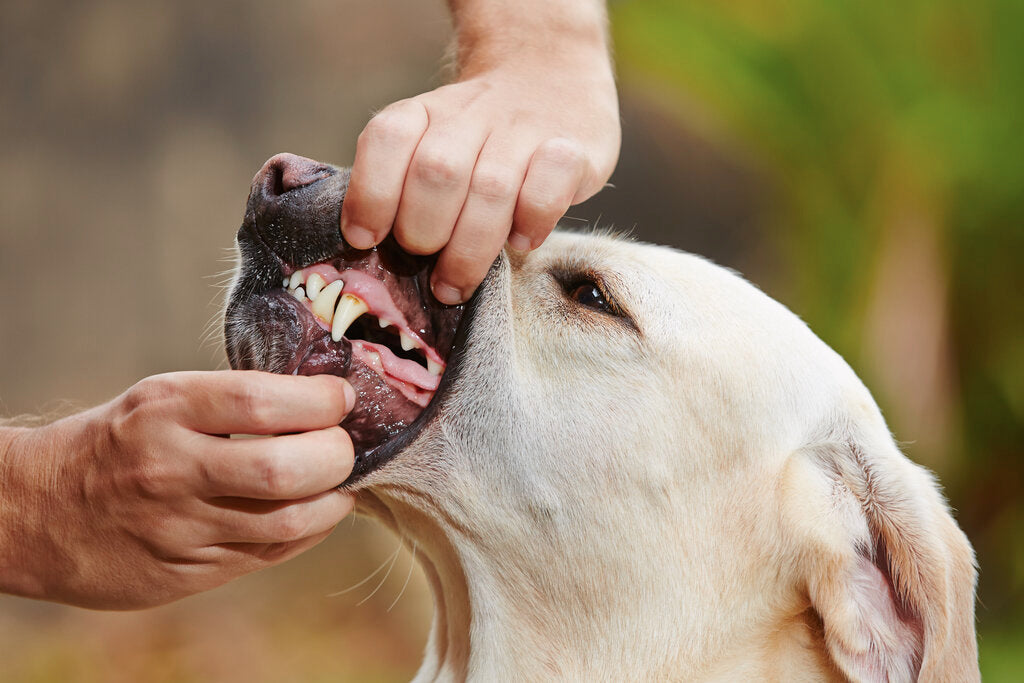Dental health plays a significant role in your dog's overall well-being, making it imperative to maintain good dental hygiene and identify potential problems early on. That's where our informative guide on five common canine dental issues comes to the rescue. We'll explore the symptoms, preventative measures, and practical tips for treatment that every responsible dog owner should know. Additionally, you'll learn how Wag & Bright's oral care products can aid in addressing these issues and promoting better oral health for your furry friend.
Armed with the knowledge from this guide, you'll be better prepared to spot the signs of dental issues and take the necessary steps to prevent or resolve them. Keep reading to learn more about maintaining your dog's dental health and how Wag & Bright's products can contribute to their ongoing care.
1. Plaque and Tartar Buildup: Causes, Symptoms, and Prevention
Plaque is a sticky film that forms on your dog's teeth as a result of bacteria and salivary proteins interacting with food particles. If not removed, plaque can harden and develop into tartar, which harbors even more bacteria and can cause oral health issues such as gingivitis and periodontal disease.
Preventative measures to limit plaque and tartar buildup include:
- Regular teeth brushing with canine-specific toothpaste and a soft-bristled toothbrush.
- Offering dental chews designed to help scrape off plaque and massage gums.
- Encouraging healthy chewing habits with dog-safe toys.
Wag & Bright's dental chews, available at Wag & Bright, are an excellent addition to your dog's dental care routine, which help combat plaque and tartar buildup while providing a fun and satisfying activity for your pet.
2. Gingivitis: Identifying Symptoms and Seeking Treatment
Gingivitis, an early stage of gum disease, is characterized by inflammation and reddening of the gums, often due to plaque buildup. While reversible with proper care, untreated gingivitis can progress into more severe periodontal disease.
Symptoms of gingivitis include:
- Mild redness or inflammation around the gumline
- Swollen or tender gums
- Bad breath
To treat and prevent gingivitis in your dog, be sure to:
- Maintain a regular teeth brushing routine
- Schedule regular veterinary dental checkups and cleanings
- Offer dog toothpaste and toothbrushes, such as those available from Wag & Bright, to help reduce plaque accumulation that contributes to gum inflammation
3. Periodontal Disease: Recognizing Severity and Taking Action
Periodontal disease, a more advanced form of gum disease, results from bacterial infection damaging the soft tissue and bone structure surrounding your dog's teeth. If left untreated, it can lead to tooth loss and even systemic health problems.
Common signs of periodontal disease include:
- Extremely bad breath
- Dark brown or black tartar on the teeth
- Loose or missing teeth
If you suspect your dog has periodontal disease, schedule a veterinary dental checkup immediately. Treatment may involve professional teeth cleanings under anesthesia, tooth extractions, or even surgical intervention.
To prevent periodontal disease:
- Be vigilant about brushing your dog's teeth
- Follow up on regular dental checkups with your veterinarian
- Use Wag & Bright's oral care products to support a healthy mouth
4. Tooth Decay or Cavities: Less Common but Still Problematic
Tooth decay or cavities, while less prevalent in dogs than humans, can still occur and cause discomfort or complications if not addressed. Cavities form when bacteria and food particles interact on the tooth's surface, creating acid that erodes tooth enamel.
Signs of tooth decay or cavities in dogs include:
- Brown or black discoloration on the tooth's surface
- Sensitivity or pain when eating or chewing
- Pawing at the mouth
Steps to prevent tooth decay and cavities in dogs:
- Maintain a consistent teeth brushing routine using appropriate toothpaste and brushes.
- Use a finger brush for dogs, such as Wag & Bright's variety, which scrapes away food particles and plaque.
- Consult with your veterinarian about fluoride treatment options.
5. Broken or Fractured Teeth: Causes, Symptoms, and Treatment Options
Broken or fractured teeth can occur from accidents, chewing on hard objects, or even as a result of dental diseases. When untreated, these injuries can lead to infection, pain, and potential tooth loss.
Signs that your dog has a broken or fractured tooth include:
- Visible cracks or chips on the tooth's surface
- Excessive drooling or blood in the saliva
- Refusal to eat or pawing at the mouth
If you suspect your dog has a broken or fractured tooth, consult your veterinarian for an assessment and treatment recommendations, which may involve dental extractions or other specialized dental procedures.
Ways to prevent broken or fractured teeth:
- Monitor your dog's chewing habits and provide only safe, non-abrasive chew toys.
- Schedule regular dental checkups to detect and address dental issues before they become severe.
- Support your dog's oral health with Wag & Bright's oral care products, which promote strong teeth and gums.
Your Dog's Dental Health Matters: Choose Wag & Bright for A Brighter Smile
Being aware of common canine dental problems and actively taking the necessary preventative measures significantly contributes to your dog's overall health and well-being. By incorporating regular teeth brushing, veterinary dental checkups, and using quality oral care products, you can help your furry friend maintain a healthier and happier mouth.
Wag & Bright's range of oral hygiene products offers effective, safe, and enjoyable solutions for supporting your dog's oral health needs. Don't let dental issues go unnoticed, and invest in the care your pet deserves today. Browse our collection now to explore their doggy toothbrush and ensure your dog's smile remains bright and healthy for years to come.

